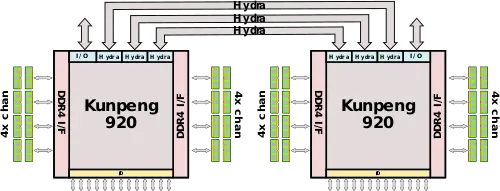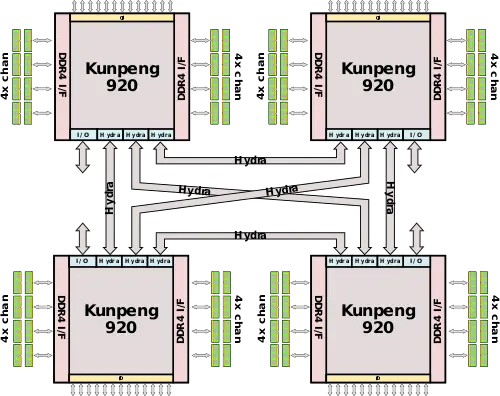From WikiChip
Difference between revisions of "hisilicon/hydra"
| Line 8: | Line 8: | ||
{| class="wikitable" | {| class="wikitable" | ||
| − | ! | + | ! colspan="4" | 2-way SMP Hydra Interface |
|- | |- | ||
! Links !! !! 10 GT/s !! 12 GT/s | ! Links !! !! 10 GT/s !! 12 GT/s | ||
|- | |- | ||
| − | | 1 || | + | | 1 || 1x8 || 10 GB/s || 12 GB/s |
|- | |- | ||
| 2 || 2x8 || 20 GB/s || 24 GB/s | | 2 || 2x8 || 20 GB/s || 24 GB/s | ||
| Line 18: | Line 18: | ||
| 3 || 3x8 || 30 GH/s || 36 GB/s | | 3 || 3x8 || 30 GH/s || 36 GB/s | ||
|} | |} | ||
| + | |||
| + | |||
| + | :[[File:Kunpeng 920 2smp.svg|500px]] | ||
| + | |||
| + | |||
| + | In a 4-way SMP, three Hydra interfaces are used per CPU with one link between each CPU, creating an all-to-all connection. | ||
| + | |||
| + | |||
| + | :[[File:Kunpeng 920 4smp.svg|500px]] | ||
Revision as of 19:46, 5 May 2019
| Interconnect Architectures | |
 | |
| Concepts | |
| General | |
| Peripheral | |
| Storage Devices | |
| Audio Devices | |
Hydra or Hydra Interface (HiLink) is a custom interface designed by HiSilicon for their Kunpeng (Hi16xx) family of ARM server processors designed to facilitate coherent symmetric multiprocessing support.
Overview
The Hydra Interface is a high-speed cache coherent interconnect architecture designed to facilitate symmetric multiprocessing between their Kunpeng processors. The Hydra interface is multiplexed over a number of extra PCIe lanes. Each Hydra interface has either x4 or 8x lanes.
When in 2-way SMP, multiple Hydra interfaces are combined.
| 2-way SMP Hydra Interface | |||
|---|---|---|---|
| Links | 10 GT/s | 12 GT/s | |
| 1 | 1x8 | 10 GB/s | 12 GB/s |
| 2 | 2x8 | 20 GB/s | 24 GB/s |
| 3 | 3x8 | 30 GH/s | 36 GB/s |
In a 4-way SMP, three Hydra interfaces are used per CPU with one link between each CPU, creating an all-to-all connection.

